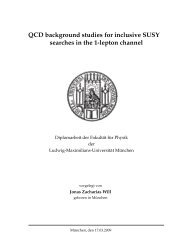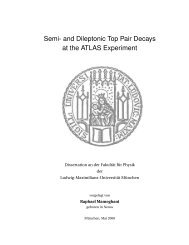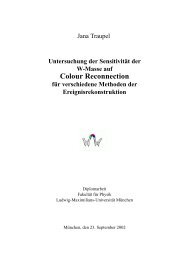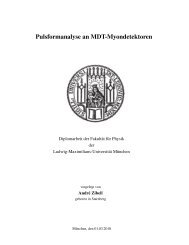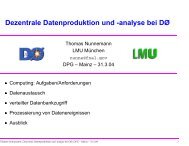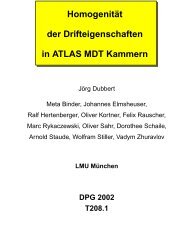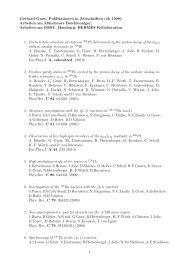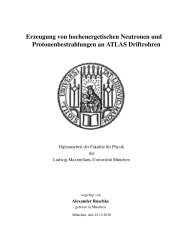development of micro-pattern gaseous detectors – gem - LMU
development of micro-pattern gaseous detectors – gem - LMU
development of micro-pattern gaseous detectors – gem - LMU
Create successful ePaper yourself
Turn your PDF publications into a flip-book with our unique Google optimized e-Paper software.
4.3. Cosmic Muon Spectrum 47<br />
to zero. Nevertheless, the fit function used in Fig. 4.9 suits the measurements in a good manner,<br />
confirmed by a χ 2 /nd f = 1.41.<br />
Figure 4.10: Energy loss distribution function for MIP βγ = 3.6 in an 1.2 cm thin Argon layer. The function<br />
corresponding to the solid line includes fluctuations. The original Landau distribution is indicated by the dotted<br />
line [Bich 06].<br />
A<br />
<br />
statement<br />
<br />
<strong>of</strong> quality for the presented data can be given by approximating the average energy loss<br />
dE <strong>of</strong> the shown distribution and comparing it with theoretical values. The 55Fe measurements<br />
dx<br />
presented in Ch. 4.1 suits for transforming the FADC scale into meaningful energy units. Since the<br />
Kα line and the Kα escape peak represent energies <strong>of</strong> 5.90 keV and 2.68 keV respectively, (see Ch.<br />
1.1.2), one derives a scaling factor by taking a data set with corresponding operation parameters.<br />
This is done via the measurement presented in Fig. 4.2. From table 4.1 one derives a linear relation<br />
between the two energies with 10% deviation. This results in a scaling factor <strong>of</strong> 9.4 eV/channel.<br />
Thus the mean value <strong>of</strong> 118.2 <strong>of</strong> the distribution in Fig. 4.9 is equivalent to a mean energy loss <strong>of</strong>:<br />
eV<br />
mean × scalingfactor = 118.2 channel × 9.4<br />
channel =<br />
<br />
dE 1111 eV<br />
≈ (4.9)<br />
dx 4mm<br />
On the other hand, the mean energy loss is related to the average energy 〈Wi〉 required for the production<br />
<strong>of</strong> primary electron-ion-pair and their total number 〈nt〉 as explained in Ch. 1.1.2. Including<br />
the theoretical values <strong>of</strong> 〈nt〉 = 97 per cm and 〈Wi〉 = 26.50 eV for Ar/CO2 at a ratio <strong>of</strong> 93/7 one<br />
derives a mean energy loss <strong>of</strong>:<br />
dE<br />
dx<br />
<br />
= 〈Wi〉 · 〈nt〉 = 26.50 eV · 97<br />
· 0.4 cm = 1028 eV (4.10)<br />
cm<br />
in 4 mm drift. The experimental results are consistent with the theoretical estimated mean energy loss<br />
within 8% deviation.



